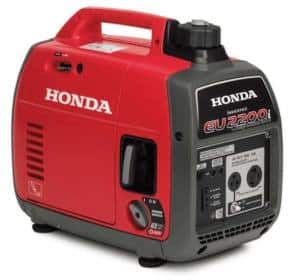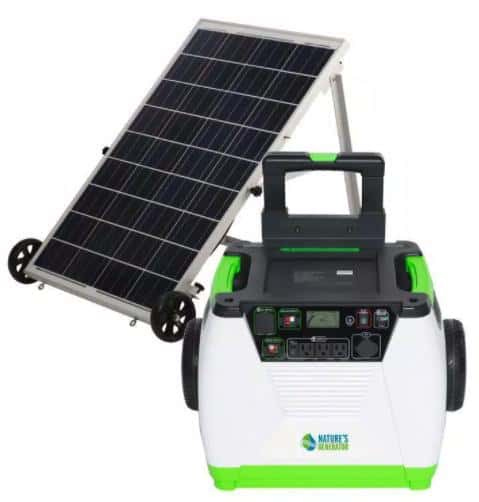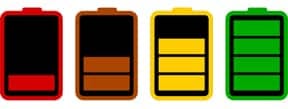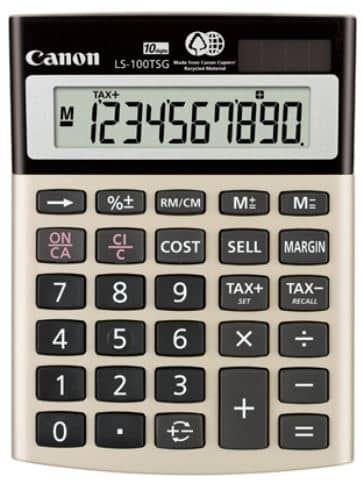A Tale of Sock Puppets and Solar Generators
Time to flex your math muscles and learn how to calculate battery energy usage
Dear Mike,
Someone on the RV Quilter FB forum asked about using a solar generator and sewing with a Singer Featherweight sewing machine. It’s 100-110 volts, 25-75 cycles at 0.4 Amperes. Doable with a solar generator? —Terry B.
Dear Terry,
You know I can’t answer a technical question with a simple YES or NO answer. This is a great opportunity to continue the discussion on just how much energy (not just watts) each appliance uses. So it’s time to break out the slide rule (or calculator if you’re not an engineering geek like me) to determine how much energy is needed to sew something like a sock puppet. Don’t worry, this is easy…
But first, what’s a “solar generator”?
A few definitions are in order, and I didn’t make the marketing hype up, so as Elton John would say, “Don’t Shoot Me I’m Only the Piano Player.”
Of course we all know what a traditional portable generator is. There’s some kind of gasoline or diesel engine with pistons and stuff (yes, I could build one from scratch if given a machine shop, appropriate materials and enough time). Its job is to spin some kind of wires and/or magnets to create current and voltage. Some generators make 3-phase DC (yes, there is such a thing), while others make AC (Alternating Current). But as long as you put gas or diesel in the tank, these portable generators will output 120 volts (or 120/240 volts) of AC for days at a time.
Solar generators to the rescue
There’s another class of portable power that uses a battery to store energy on board, rather than filling up the tank with petrol or whatever. These are also called solar “generators” by marketing people who want you think they can function like a gasoline generator.
However, in reality they’re just a battery in a box with some kind of inverter to change the 12-volts DC into 120-volt AC. They can be handy, but you need to recharge the battery from another electrical source like a wall outlet or the 12-volt DC outlet in your vehicle.
Here comes the sun
By adding solar panels to this battery-powered generator, marketing types figured they can now call their product a “solar generator.” And it does indeed “generate” electricity from the sun.
Sounds like a clean solution to your sewing machine question, doesn’t it? And if you look at the first page of marketing hype it seems a little too good to be true, doesn’t it? Wow, it’s 1800 watts “with Electric Start.” What does that mean?
Let’s read the fine print on this solar generator
But, if we expand the screen and look further down the page we come up with this little gem of information.
How much energy can it store and how fast can it recharge from the solar panel?
Those are the first two questions we need to answer before we can calculate how many sock puppets or wedding gowns we can sew from one of these solar generators. Yes, I’m going to calculate how much energy it takes to sew a sock puppet, so be prepared.
While it does have a 1800-watt peak (1440 running watts) pure sine wave inverter, there’s only a 60 Amp-Hr (720 watt-hr) SLA (Sealed Lead Acid or Gel) battery inside. Those two pieces of information are critical for us to understand how big of an appliance it can run, and how long it can operate before running out of battery power. Note that a SLA or AGM battery should only be discharged down to 50%, unlike a Lithium battery which is rated for discharge down to 0% without damage.
Charging time….
First, let’s do a quick calculation on how long it would take a 100-watt solar panel (yes, that’s what’s included) to fully recharge a 720 watt-hr (60 amp-hrs at 12 volts = 720 watt-hrs) battery. Now you can’t just multiply the 100 watts of solar power output at high noon by 10 hours of sunlight to come up with a number. You have to consider clouds, angle of the sun, shade from trees, etc… In general, a 100-watt solar panel is good for an average daily output of around 300 to 400 watt-hrs.
Now that we have everything in watts and watt-hrs, we simply divide the 720 watt-hrs of energy we need to put back in the battery by the 300 watt-hrs per day that the 100-watt solar panel can provide. That’s 2 to 2.5 days (720/300=2.4) of sitting in the sun with nothing being used from the battery just to recharge it fully.
Discharging time…
Since they say in their literature that it can provide 1,440 running watts of 120-volt AC power, let’s calculate how long it can do this from a battery charge. We just have to divide 720 watt-hrs of stored energy by the 1,440 watts we want to use (720/1,440=0.5 hrs or 30 minutes) to find it will flatten the battery to 0% SOC (State of Charge) in around 30 minutes.
What about sewing machines and sock puppets?
In the reader’s question, they asked about using a sewing machine that pulled 0.4 amps of current at 120 volts. So to find watts we just need to multiply 0.4 amperes x 120 volts and come up with around 50 watts (48 if you’re not rounding up).
To find out how long you could run this sewing machine motor at full throttle, we just need to divide 720 watt-hrs of available energy (down to 0% SOC) by 50 watts to run the motor (720/50=14.4). and come up with around 14 hours of running time.
Now, your mileage will vary because I haven’t included any other losses in the system. So let’s throw away 20% of this for efficiency losses and come up with around 12 hours of run time.
How much energy does a sewing machine need to make a sock puppet?
I asked my wife (who used to do a lot of sewing) how long it would take her to sew a sock puppet like this one. After she stopped laughing at me, she said it would take her around an hour to make one of these. I’m guessing that the duty cycle of the motor would be around 50% of sewing machine run time.
That suggests that each sock puppet would require around 30 minutes of run time (or 25 watt-hrs). We already calculated 14 hours of available power with just the sewing machine motor running. So for my highly WAG (Wild A** Guess), I’m going to say that you could sew around 28 of these sock puppets from a single charge of this solar generator.
But what about the sun?
And yes, considering that the sun could resupply around 300 watt-hrs of energy per day, and each sock puppet requires 25 watt-hrs of electricity to sew, you could be making 12 sock puppet per day, just on the solar panel’s recharging ability. So, ad infinitum, as it were…
So, will this work?
Yes, it should work nicely for this type of sewing. And if you’re making wedding dresses that require perhaps 100 hours of sewing time over the period of two weeks, then it could still work as long as you don’t go too much over 12 hours of sewing time per day.
Final analysis regarding solar generators
So, things that draw a small amount of power (like a sewing machine) are good candidates for these solar generators. However, trying power an 1,500-watt hair dryer (for your RV barber shop) would quickly deplete the storage battery in 30 minutes. That would be maybe 5 or 6 customers if it takes you 5 minutes to you blow-dry each head of hair.
Let’s play safe out there…. Mike

















Interesting analysis Mike. It is surprising how many factors there are to consider. Thanks for sharing your thoughtful considerations. Here is a similar but even more complex problem. What does it take to run a Starlink dish and router with a power station and solar panels or a solar generator (as it were)? The first question is which version of the Starlink hardware are we considering and how much power does it consume? If one just considers the latest generation, then we learn that the power it consumes depends on multiple factors which include whether it is idling or under heavy use and the weather as the dish can melt snow. It also depends on the length of cable used (since it employs power over Ethernet) and the greater the cable length, the more line loss, and the more power consumed. It also matters whether the use case is temporary or permanent. For example, the situation is very different for someone camping for a few days or powering an off-grid cabin, or just backing it up during power outages.
The bottom line is that it is complicated and situation dependent. I’m guessing many RVers have found practical solutions by trial and error or by measuring the power consumption of their system either in real time under different conditions or over time blocks like 8, 12, or 24 hours using a power station. I found a YouTube video where someone did a test that showed a Jackery 1000 could run their Starlink for 14 hours which would imply about 70 W average power consumption.
I’d be very interested in hearing what you or other readers have to say about their experiences with powering Starlink systems in RVs and off-grid cabins or homes.